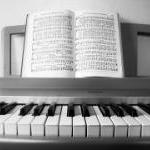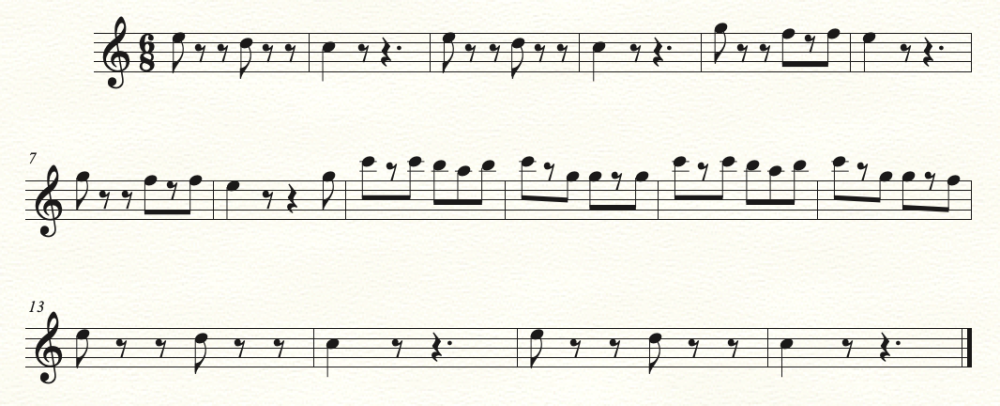All Activity
- Today
-

Oboe Concerto
GospelPiano12 replied to GospelPiano12's topic in Incomplete Works; Writer's Block and Suggestions
I will fix the parellels Yes and no lol - I liked the bass doing that contrasting figure (rhythmic wise) with the half note and qtr note, and I liked the 5ths, so I just kept it in. It's not super bad, could definitely be smoother, so I'll edit that spot. Thanks! Thanks for all your feedback -
.thumb.jpg.e5f26b712b4f9622f521b10d8a53c6d6.jpg)
Intervalic piece for Horn and Piano
Samuel_vangogh replied to Samuel_vangogh's topic in Chamber Music
Thank you! Cantus articus is my personal favourite, i shall take all of this into consideration! -
That totally makes sense. Like I said, abruptness isn't a bad thing, but aurally justified abruptness often feels more satisfying, and I think that's more the vibe you're going for with this; that is to say, I don't think you're going for something intentionally incoherent. As another example (also about birds lol) here's the first movement of Cantus Arcticus: listen as more and more weird little figures gets added to this texture, some of them very out of character, but then you sort of... get used to it. Rautavaara takes the time to make you feel like those additions are worth it, you know? (Timestamped): https://youtu.be/TO3YRZWLvQo?t=60
-
.thumb.jpg.e5f26b712b4f9622f521b10d8a53c6d6.jpg)
Intervalic piece for Horn and Piano
Samuel_vangogh replied to Samuel_vangogh's topic in Chamber Music
@Monarcheon Hey whoah! Thank you for your feedback! I'll definitely check that piece! As for the abrupt register changes: its kinda of a musical effect, since this piece is written after the conversation a duck and a bird had on my window when i was playing piano, so i wanted to represent the odd yet amusing change in sounds and flow between the two animals -
.thumb.jpg.e5f26b712b4f9622f521b10d8a53c6d6.jpg)
Intervalic piece for Horn and Piano
Samuel_vangogh replied to Samuel_vangogh's topic in Chamber Music
. -
Interesting work! It definitely borders on atonal, with some definite centricity on A that keeps it from going too far out of bounds. In fact, you've got an interesting arc here, with two (014) trichords at the beginning and end being sort of "built" off the tonic and dominant of A, even cooler because the "0" in both cases isn't the same note. It's a cool idea, something that George Walker probably would have been fond of. If there's one thing I'd point out is that a lot of the register and dynamic jumps feel a little abrupt. Now, don't get me wrong, I know that happens all the time in more avant-garde music (e.g., Crumb), but—I don't know—it feels like those have a little more pomp and circumstance to them because of the way they grow and decay. For that reason, I'd suggest playing with rhythm a lot more; giving yourself the space to do some really interesting rhythmic interplay will immerse your listener in the intervallic web you want to make instead of necessarily always having to be explicit about it with discrete musical cells of vertical harmonies and lines. The last of Saariaho's Papillons is a good example. Lots of semitones in there but it oscillates so much you just sort of recognize it implicitly and it flows between different playing styles (timestamped): Nitpicks: 1. You have it listed as Horn in F; make sure your score actually is in F (it's concert right now). 2. The fun thing about truly atonal music is that the spelling doesn't matter a ton; it's different here because you've got a pseudo-tonal thing going on, but even still, I don't think there's a need to have unnecessarily uncommon spellings like the E# in the last three measures. 3. Keep clef changes where the notes are played, not the beginning of the bar, e.g., mm. 13, 15. 4. The semitone addition in mm. 13–14 is a cool muddy echo, but I kind of want more out of it; maybe go even further into the depths?
-
TristanTheTristan started following Do you improvise?
-
Yeah, cadenzas are fun.
-
Simple motives are the best, and you've got a good one going. If you're able and not sick of it, I'd really try to take this piece and develop it (not necessarily expand it), because there's a lot that could be done here, especially since you're so early in the learning process. 1. It's good that your main motive has rhythmic variation, but I'm not always so certain that it's intentional. For instance, the version we hear at the beginning sounds cleaner to me as the kind you have in mm. 35 and 39. The variation you have in the F minor section between straight eighths and the dotted figures is nice, though. 2. A couple jumps in technique that sound a little abrupt, talking about mm. 21 and 44. It's a pretty substantial change and it doesn't feel like it's supported well enough to me. A bigger lead in/out or a pattern change in the left hand could help with that. 3. The resolution at m. 56 jumps out to me as a little odd; it's plagal in A-flat major, but coming off of VI in the original key makes it feel a little sudden because you have two tonic-functioning chords in a row. Your bass counterpoint in that phrase is very smooth, so use that to your advantage and really sell that modulation melodically; I don't think you have to be so harmonic about it. 4. I'm not entirely sure what you want to do with the end section. The chromatic lines against the new tonic are pretty cool (I think some people call them line clichés, but I don't remember), but it's an entirely new key, so I'd take the extra time to really justify that big change. You've got a decent start to an idea, but it's not just repetition that makes things sound proper, but the time and space to make those things feel worth it. 5. In that vein, I'd also let yourself develop the melody more. You have two distinct sections in two different keys (the waltz part at least) with a decently strong melodic idea; I can tell you know that it needs more variation because of the flourishes and stuff I mentioned in Point 2, but what if you made those variations two or four or eight or sixteen bars or a whole new section... you see where I'm going with this? There's a fine line between developing an idea and wasting the audience's time and I'd encourage you to try to explore what that line is. Like I said, great ideas; I'm excited for this and you!
-

Piano Suite No. 1 | No. 1: Whimsy
ferrum.wav replied to ferrum.wav's topic in Piano Music, Solo Keyboard
also update on the suite ig (note that this does not include the scoring process) No. 2 : Home (Omah) | 80% No. 3 : Scherzo | 60% No. 4 : Affection | 20% No. 5 : Festive | still haven't started anything yet, though I already thought of the opening -

Piano Suite No. 1 | No. 1: Whimsy
ferrum.wav replied to ferrum.wav's topic in Piano Music, Solo Keyboard
I'm with ya dude. I have the same dilemma, except on the other side. Sometimes, the return to an existing theme or a development of one gets distorted within my variations that the listeners could perceive it as a different theme entirely. For example, while composing No. 3 (Scherzo), I had wanted to repeat the stating of the B theme with a little variation. However, since the A section has a similar jazzy/improv style with No. 1, I had to force myself to put a repeat sign so that I clearly stated the theme and didn't variate it much further. Anyways, thanks for the feedback! Glad you feel the whimsyyy -
EmotionallyChargedMusic started following Sci-Fi Facility Exploration
-
I have made a looping track for an arcade style game where the players explore an abandoned scifi facility and the robots wake up and need to be terminated
-

"Turmoil" for Brass Quintet | Kyle Hilton (UncleRed99)
Monarcheon replied to UncleRed99's topic in Chamber Music
It is a pretty nice soundfont, eh? Well done, with some nice dynamics peaks and valleys that sound very justified. I think I'm with @PeterthePapercomPoser on a lot of my feelings; it sounds like there's a little bit of inconsistent energy throughout the work. You set up, for instance, a really compelling idea starting at m. 12, and it grows from there, but over time it feels like the energy dissipates even though my brain wants it to go further. I remember feeling like the slow stuff after the faster notes was in some sort of alla breve and it was really cool, but it stayed there, and it felt like it died out a bit. I think letting one or two of your instruments have some contrapuntal rhythmic drive would go a long way, even if it's just some generic "have more notes here" kinda writing. m. 32–33 is a prime example of this for me; what a cool little entrance figure—it'd be awesome if that rhythmic profile continued! But it just kind of stops, in my opinion. Like this passage from Mendelssohn's A Midsummer Night's Dream "Overture" is just a bunch of half notes with one note being repeated a bunch under it and it does the job (timestamped) : https://youtu.be/qU0d0zuNn7k?t=92 Basically, give yourself the time to build! It ain't an ice sculpture 🙂 Nitpicks: 1. m. 17, better to have the dotted quarter as a quarter tied to an eighth. 2. m. 14 and all bars like it in T2, you might consider having things beamed by the beat for easier reading. 3. The triplet figure in mm. 3 and 7 feel a little inconclusive ending on different notes for some reason. Not sure why, that's pretty common. Maybe something to do with the support in the rest of the ensemble. Nice little work! -
UncleRed99 started following Favorite video game music tracks?
-
This popped up in my sidebar. I'm 5 years late to this conversation, but I have to add in an OST I don't think is being mentioned in this thread (as far as I've read anyhow). ALL time favorite video game OST has to be, hands down, The Halo Trilogy (+ODST and Reach OSTs) Soundtracks. Or rather, the original Bungie soundtracks composed by Martin O'Donnell and Michael Salvatori. One of their tracks also featured Steve Vai (😎) which is too epic to ignore. Here's a couple of my favorite tracks throughout the years of my childhood playing Halo and now in my adulthood, can much better appreciate the artistic work that went behind these, in their totality. (I have a transcription feat. Halo: Reach tracks, in my pocket that I don't think I've shared here that I will share soon 🙂 This is the first track in that Medley) This one has always struck a chord in my heart. It's the piece you hear at the end of Halo 3: the end of the trilogy. We all thought this would be the last game in the Bungie saga. So for the credits to roll with this piece being the sound that walked us into that slow fade to black, is nostalgic as all h3ll 😞 Here's probably one of my all time favorite tracks from O'Donnell and Salvatori. Just allowing that backing track to take you on a journey, with the subtle sound of Rain, and the amount of space given for the sounds from the Piano & Saxophone to just resonate in your memory for a bit, was just genius. Just a few examples... Much much more work in those games that just strike a chord. An Honorable mention, from the 343 Industries team when they took over for Halo 4 and beyond, would be the Halo 4 track; Kazuma Jinnouchi did very very well to pay homage to O'Donnell and Salvatori here. Really allowed me to respect what the Composers did for this game's track, well. I was afraid I wouldn't like this title entry. But the music saved it for sure, in my eyes.
-
Hi, there. Most of this looks pretty good. I echo a lot of @JorgeDavid's notes, particularly: I also noticed that m. 23 has both voices move above the highest note of m. 22 (voice overlap). m. 32 also has a repeated note going into m. 33. One of these things that is, like, not really wrong, but feels like an augmentated second-species counterpoint, so we try to avoid them. There's a 3-6 linear intervallic pattern (sequence) in the first exercise, which is one of those things that feels like it should be fine because it's not parallel imperfect consonances, but falls short in feeling like the voices are moving independently (the historical point of these exercises, arguably). Keep it up!
-
Wonderful little work. The <sol, fa, me> imitation at the end is one of those little things that make me smile when I hear them. Not sure if you're a stickler for conventions. It's entirely possible you know better than me; I'm sure they're likely one of those things that you see in the repertoire and you teach students not to do it anyway (happens a lot), but: 1. I notice an augmented second in m. 3. Odder still is that it's followed by a leap. 2. In m. 7, the second beat has one of two potential issues: either it's a iv chord without a third (!!!) or it's a iiø6/5 without the fifth, which students are taught that when you have an inverted seventh chord, all the chord tones should be present. It sounds great so who cares—and like I said, it looks like you probably know more than I do about the actual Baroque conventions—but they're just things that popped out. I'd be interested to know if they are just stylistic norms that I don't know!
-

Nocturne in C-sharp minor
Henry Ng Tsz Kiu replied to Henry Ng Tsz Kiu's topic in Piano Music, Solo Keyboard
Haha thx Vince, you are right that the 16 year old Henry couldn't play this at all, nor could he finish the whole piece! I just feel somewhat bored while having no output for several months despite lots of input, so I chose this one to rework! Henry -

Nocturne in C-sharp minor
Henry Ng Tsz Kiu replied to Henry Ng Tsz Kiu's topic in Piano Music, Solo Keyboard
Thank you Sam! I don't know why the 16 year old Henry decided to modulate to F major at that time but looks like it work! I do like the climactic section, it's the section I revise a bit since the 16 year old Henry only left drafts in it lol!! Henry -
Henry Ng Tsz Kiu started following the 3rd Movement Of Moonlight Sonata orchasrated
-
PeterthePapercomPoser started following Monarcheon
- Yesterday
-
.thumb.png.8b5b433a341551e913a34392660bc95b.png)
Gothic Tarantella for Violin and Clavichord
PeterthePapercomPoser replied to PeterthePapercomPoser's topic in Chamber Music
Ah, hahaha! How could I have forgotten about the "Three Blind Mice" song? Yeah I can definitely hear the resemblance now. You didn't come across as too critical at all! I think we need more reviewers and string aficionados like you to be more active here giving the members some really great and much needed advice! Thanks for your input! -

Gothic Tarantella for Violin and Clavichord
Monarcheon replied to PeterthePapercomPoser's topic in Chamber Music
Ah, I meant the children's song, "Three Blind Mice." Surely you've heard it (attached)? Anyway, it was fun to come back and see what's up. I mean, that's totally fair; the arco would definitely give it a sharper bite. And nah, wouldn't be too quick; they player would keep the hand in the bow position while plucking it (though they may complain about it). Obviously, up to you. I realize I may have come across as too negative with all the criticism—I think this piece is super cool and I'd love to hear the version with the expanded middle section if you ever get to it. -
.thumb.png.8b5b433a341551e913a34392660bc95b.png)
Gothic Tarantella for Violin and Clavichord
PeterthePapercomPoser replied to PeterthePapercomPoser's topic in Chamber Music
Thanks! It's been a hot minute since you've been here! Glad to see you reviewing again! As mentioned in the description - the piece is inspired by the show "Wednesday" as in Wednesday Addams from the Addams Family. I haven't seen Three Blind Mice either. Ah, yes. I haven't thought about how the roll suddenly includes more notes and in that regard, contradicts the decrescendo. Perhaps in a performance the number of notes in the stop could be reduced, maybe all the way down to only two notes as you suggested. I kind of like them arco. Besides, wouldn't it be too much switching between arco and pizzicato too quickly? Perhaps you're right there. I had planned for the middle contrasting section to be longer giving the key change more utility/necessity. Your nit-picks are also duly noted. Thanks again for your detailed review! -

Gothic Tarantella for Violin and Clavichord
Monarcheon replied to PeterthePapercomPoser's topic in Chamber Music
Cool stuff. I'm gonna guess you were quoting Three Blind Mice; I haven't seen the show. If not—well, you might have reinvented the wheel. A couple things: 1. I'm not sure how I like the quiet rolls at the ends of phrases. I know they're possible, but they're gonna be a little awkward and take time, delaying the nice quiet resolution. If I were to suggest a change, I'd maybe consider doing a two note thing (like a grace note + final note kinda thing), with some rolled figure in the keyboard to supplement the effect. 2. I'm guessing you want your many grace notes to connect to the triplet figure that come after them? I'd suggest being really explicit about that if so; string players are literal (e.g., don't bother giving string players phrasing slurs). 3. mm. 23–24 and 72–73: My brain kind of wants to hear some of these plucked for some timbral variety, especially since the keyboard takes over there. Something like the first note is arco, the others are plucked, until the anacrusis to the next bar. 4. I don't think your slow section needs a key signature change, personally, especially because I don't hear your key centers as the implied I–bVI–IV of A-flat major. Think of it like musical theater: you change keys so goddamn much that sometimes it ain't worth it. (Also F-flat major is kinda obnoxious to read). Nitpicks: a. Could use some more courtesy accidentals, when used in succession. For instance, throw a courtesy in m. 41 just for funsies. b. D/C double stop is kinda annoying, and very sad that it moves to Eb/A, which can't use the open A. I see the voice leading, it could maybe be a little more practical, though. c. Make sure dynamics are on the notes played. I think we really only put dynamics if it's "n" at the end of the note's duration. Maybe it's for the playback. d. Last measure: take out the rests in the right hand, since it's written like the right hand is doing a register transfer to a lower octave. Really fun stuff. Congrats.






